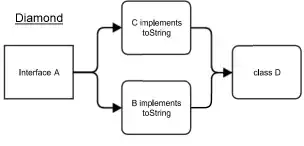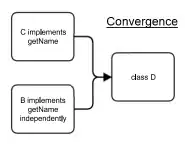Whenever I read something like this:
Many programmers exhibit a slight, involuntary shudder whenever multiple inheritance is mentioned. Ask them to identify the source of their unease and they will almost certainly finger the so-called Deadly Diamond of Death inheritance pattern. In this pattern, classes B and C both inherit from class A, while class D inherits from both B and C. If B and C both override some method from A, there is uncertainty as to which implementation D should inherit.
I cannot come back and not to ask: why do you reduce multiple inheritance problem to the Diamond problem? Do you understand that problem is the name conflict that stems from convergence of classes, rather than their reconvergence (diamond)? You do not need the common root A class/interface for the naming conflict to happen, as the diagram shows
It is MI which enables the class convergence and, thus, naming conflicts, which are the problem we are talking about. Why do you pff like it is not the case and keep calling it a diamond problem rather than MI problem?

